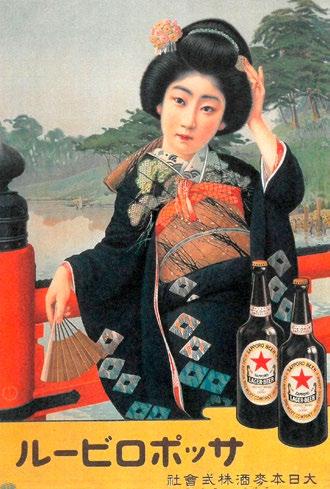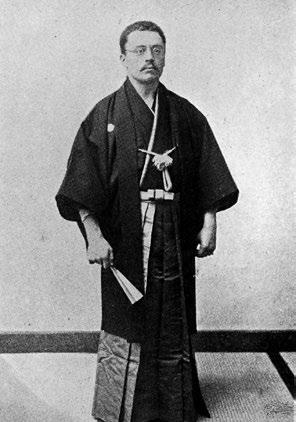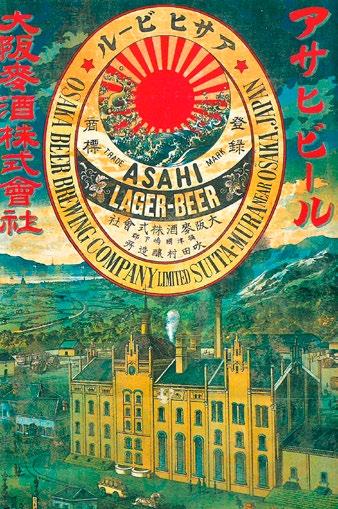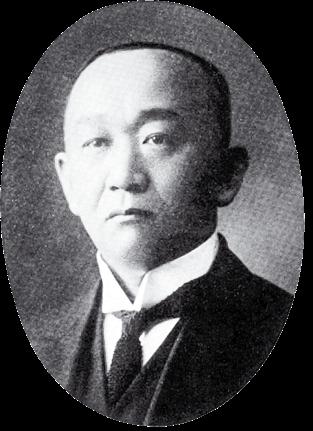
10 minute read
History: Japan – a beer-loving nation, part one: From the opening of the country in 1860 to the trends of the 1980s
HISTORY
Japan – a beer-loving nation, part one: From the opening of the country in 1860 to the trends of the 1980s
Michaela Knör (Axel Simon Library, VLB Berlin)
If you ask about the most important beer-culture countries, the Czech Republic, Belgium, the United Kingdom, and Germany are often the names mentioned. Nobody thinks of Japan – but people should. Because beer has always played a major role in this East Asian country.
Since the late 1890s, the German master brewer Wilhelm Coblitz had been responsible for production in the
Yebisu brewery
Beer is an important beverage in CentralEurope –both asa foodstuff and as a luxury. It has been brewed and drunk in the Czech Republic, Belgium, the United Kingdom, and Germany for centuries. The quality of the beer hailing from these countries is well-known far beyond their borders – people now appreciate the moreish drink all around the world as it triumphantly marches from the heart of our continent to every corner of the globe. But over the past century or two, this “substance” – a prominent feature of social life in Germany – has also established itself in countries where the drinking and living cultures were originally shaped by alcoholic beverages of a very differentnature.Take Japan, for example.
Sake or beer
Sake has always been the traditional alcoholic beverage in the Land of the Rising Sun. It’s worth mentioning, however, that there is a lot to be said for the relationship between sake and beer. Although sake is misleadingly referred to as rice wine in Western usage, the way it is produced is more similar to that of beer than to that of wine. This is because, as with beer, the starch
must first be broken down. However, this is not done by malting the rice, but through a multi-stage process. The fact that the first written mention of “biiru” (beer) is found in texts dating back to 1800 describing it as “migusake” (barley sake) also points towards the connection between the two. But Japan’s contact with beer in the European sense was minimal until the 1860s – it was only brought into the country by Dutch traders and scholars. It took Japan ending its isolationist foreign policy and the opening of the island kingdom, which sealed itself off from the world and severely restricted trade until the middle of the 19 th century, to kickstart its development into a beer nation. The window to the outside world only opened with the signing of the friendship treaty between the United States and Japan, the Convention of Kanagawa (Nichibei Washin Jōyaku). Thanks to this contractual agreement, a number of European traders settled in the port area of Yokohama in the following years. The merchants who lived there in something akin to a colony also imported the beers from their respective homes, as well as other goods, thus introducing mainly English and German beers to the nation and gradually making them better known among the local population.
Development into an industrial nation
The Meiji Restoration (1868–1912) heralded a phase of renewal in which Japan developed from a

strictly isolated, agriculturally dominated feudal state to a Western-oriented industrial nation. This “take-off” climate saw a lively cultural exchange begin with some Western countries. Products from the United States and Europe became fashionable among the locals. In many places, breweries were established that brewed beer in the English or German styles. Towards the end of the 19 th century, there were more than 150 breweries scattered across the country. However, many of these establishments only had a rather short life span. Insufficientfinancialresources, the difficulty in procuring the raw materials, a lack of expertise, and practically non-existent sales structures all took their toll. The beer tax introduced in 1901, which the governmentused to finance the
establishment of the military, among other things, meant the end for many of these small breweries in particular. Ultimately, only three of the breweries from this period of rapid industrial expansion survived the consolidation phase. Another company joined this trio in the 1960s to form the quartet of major players that dominate the Japanese beer market today.
Kirin
The Kirin Brewery, the predecessor of which was founded in around 1870 by William Copeland (1832–1902), has the longest tradition to look back on. Copeland, an American with Norwegian roots and an education in German brewing techniques, established the Spring Valley Brewery in Yokohama’s “foreigner district,” where he produced mainly lager beer, Bavarian beer, and bock beer. However, arguments with his German-born business partner and the resulting economic difficulties resulted in him having to close it by 1885. The new owner was a consortium of British, German, and Japanese investors (Japan Beer Limited), which fitted the brewery with the latest German technology and assigned the production management to a brewmaster from Germany. In 1888, Japan Beer Limited launched Kirin beer on the market under the leadership of brewmaster Moritz Hermann Eckert. It’s not only the beer that has borne the Kirin moniker since 1899, but the brewery, too – the name refers to a mythical creature that is thought to be a symbol of luck. Beer production remained in German hands until 1914, when the outbreak of the First World War made enemies of Japan and Germany. One of the people to take up this position was Erwin F. Eichelberg, who held it for 15 years from 1899. He graduated from the VLB Berlin brewing school in 1898.
Sapporo, Yebisu, Asahi
Breweries were also established in other places, with one of them being on Hokkaido. The northernmost island of Japan has been developed by order of the government since the beginning of the Meiji period, since officialestimates claimed the
island’s climatic conditions made it seem particularly suitable for growing hops. As such, construction on the state-run Kaitakushi Beer Brewery began in the city of Sapporo in the spring of 1876. The first kegs rolled offthe production line atthe end of that same year. Nakagawa Seibei was the brewmaster – a local who had studied at the Tivoli Brewery in Berlin and Fürstenwalde and received his master craftsman’s diploma in the 1870s. Under his supervision, bottom-fermented lager beer was produced on Hokkaido using malt and hops from Germany, which was marketed as Sapporo beer and sold well. In Tokyo, bank director Kyohei Makoshi founded the Yebisu Brewery together with business partners in 1889. This new brewery also opted for German technology and expertize in terms of equipment and personnel – probably with the successful Kirin and Sapporo breweries in mind. Wilhelm Coblitz was the man holding the reins as brewmaster; a position he had held since the late 1890s. Coblitz, also a graduate of the VLB Berlin brewery school (winter semester 1897), trained Kojiro Makoshi, the son of the company founder, Kyohei Makoshi, there between 1900 and 1901. He then traveled to Germany and, after his practical training at the Vereinsbrauerei Apolda and the Städtische Dampfbrauerei Jena, attended the winter course at VLB Berlin in October 1903. Following his return to

Japan, he first headed the laboratory of the brewery before later becoming brewery director. The 140 others he studied alongside on the winter course in 1903/1904 hailed from all over the world. including Russia, France, Denmark, Sweden, as well as every corner of the German Reich, but there was also a fellow countryman on the course. Shigetaka Miyake had gained the practical experience necessary for his studies at the Suita Brewery in Osaka. This brewery was founded in 1889 as Osaka Bīru Kaisha. Among others, a samurai and the head of a sake brewery were involved in its foundation. And just like the other brewing companies, Osaka Bīru Kaisha (later Asahi) also relied on technology and staff from Germany.
Dainippon
At the beginning of the 20 th century, Japan’s leading breweries all employed German brewmasters and relied on technical equipment from Germany. Bavarian beer or lager beer was the most popular beer in Japan, just like it was in Germany. At that time, the government repeatedly raised the tax on beerto continue financingthe military, such as operations in the Russian-Japanese War of 1904/1905. That led to the three breweries mentioned above uniting under the leadership of Kyohei Makoshi to form the Dainippon Beer Brewery in 1906. But the death blow for small breweries (and the home brewers) came in 1908, when the government set a minimum production quantity of 1800 hl. Four years after the end of the Second World War in 1949, Dainippon was split into two companies, Asahi Beer (Asahi Bīru Kabushiki-gaisha – Asahi Breweries, Ltd.) and Nihon Beer, which was later renamed Sapporo Bīru kabushiki kaisha (Sapporo Breweries Limited). Including Kirin, this meant that the beer market in

Kojiro Makoshi was trained in Germany around 1900 and prepared for his position as director of the Yebisu brewery
Japan was shared between three major breweries at the beginning of the 1950s. In order to further increase the revenue from the alcohol tax, the minimum production volume was increased to 20000 hl, meaning the government had definitively prevented smaller breweries from entering the market or setting up new ones.
Suntory
Despite this hurdle, another player took to the stage in 1963 in the form of Suntory, which up until that point had made its money in whisky production. Suntory had experience with Western beverages and, like its already established competitors, initially focused on the production of lager beers. To differentiate itself from the competition and to gain a market advantage, Suntory launched an unpasteurized beer, which was preserved by microfiltration, in 1976. This beer, known as Nama (raw), impressed consumers with its freshness and was well received by Japanese consumers. Reason enough for the other breweries to follow suit.
Museum of Yebisu Beer in Tokyo
Today, the Museum of Yebisu Beer is located on the site of the former Yebisu Brewery. It was opened in 2010 to celebrate 120 years of the beer. The importance that the brewery had for the development of the district in the heart of Tokyo is palpable. The name of the brewery has changed to the district, which is now called Ebisu. Exhibits from the history of the brewery and its products are on display across approximately 500 m 2 of exhibition space. The photos and advertising media are particularly interesting. They bear witness to how beer as a beverage has found its way into Japanese eating and drinking culture. The types of beer that the Yebisu brand currently produces can also be tasted in the restaurant area of the museum. Entry is free. However, tours are subject to a fee, although they are currently only offered in Japanese.
New trends
In 1971, the Sapporo Brewery was able to gain a market share through the relaunch of the Yebisu brand – a beer brewed strictly according to the German Reinheitsgebot (the German Purity Law) and sold as a premium drink for special occasions. The Yebisu-Sama (god of luck), who has been depicted on the labels since the brewery’s founding days, may have had something to do with this. The Kirin Brewery, which was actually the smallest brewing group following the break-up of Dainippon, focused its efforts on tapping into the trend of drinking beer at home. Kirin sold its top product, Kirin Lager, mainly through the food trade, enabling it to grab a market share of over 60 %. Asahi also battled for a good market position. In 1986, the company gave itself a new corporate identity and launched a beer that, according to a consumer survey carried out in 1987, set the standard: Asahi Super Dry. The light lager beer quickly became the most popular beer in Japan – and is still number one today.
Orion
Forthesakeofcompleteness,a fifth brewery group, Orion Breweries, Ltd., which has found at least one niche in the Japanese beer market, also deserves a mention. Orion was founded in 1957 during the U.S. occupation and has its headquarters on the island Okinawa in the very south of the country. The brewery’s American-style beer was able to secure it a market share of about 60 % – at least in the prefecture of Okinawa with its approximately 150 islands. The company has been cooperating with Asahi Breweries since 2002 to open markets outside of the archipelago.
Photo: Michaela Knör
Contact: knoer@vlb-berlin.org

Part two will be published in Brauerei Forum, issue 11 (release date: 9 November 2020), and will look at the development of the Japanese beer market from the mid-1980s through to today. As in other countries, the craft beer sector plays a major role in this.









